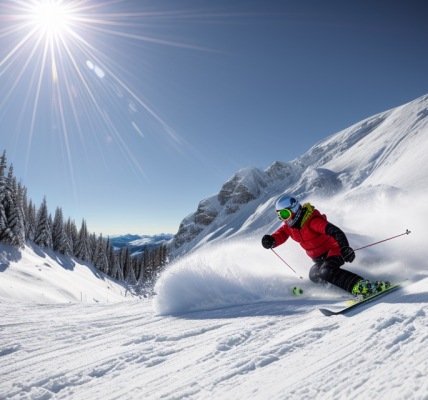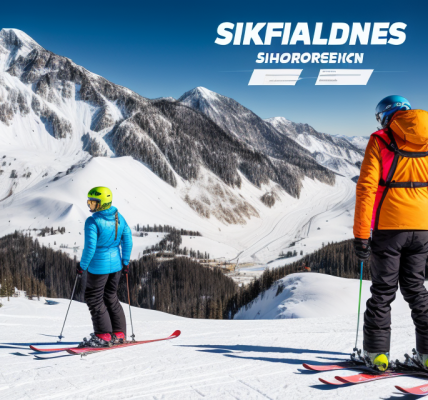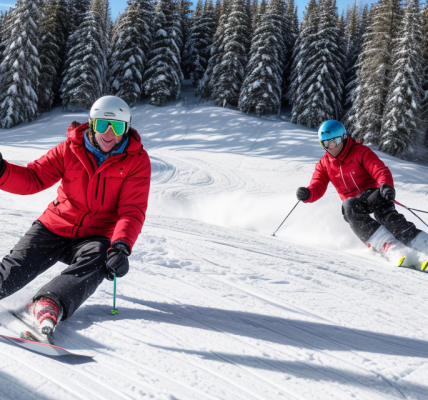Skiing is a thrilling and exhilarating sport that involves gliding down snow-covered slopes using skis. It is a popular winter activity that is enjoyed by people of all ages and skill levels. But what category of sport is skiing? Is it a winter sport, an extreme sport, or something else entirely? In this article, we will explore the answer to this question and discover what makes skiing such a unique and exciting sport. Whether you are a seasoned skier or a beginner, this article will provide you with valuable insights into the world of skiing and its place in the world of sports. So, buckle up and get ready to learn more about this exciting and dynamic sport!
Skiing is a winter sport that belongs to the category of winter sports or alpine sports. It involves descending a snow-covered slope using skis, with the help of poles and sometimes a snowboard. Skiing can be performed on both natural snow and artificial snow created by snow cannons. It requires physical strength, coordination, and technical skills to control the speed and direction of the descent. Skiing can be practiced for recreation, competition, or as a means of transportation in snowy regions.
Definition of skiing
Alpine skiing
Alpine skiing is a discipline of skiing that involves descending a snow-covered slope, using a set of skis with fixed-heel bindings. It is a high-speed sport that requires both technical skill and physical fitness.
Alpine skiing can be broken down into several different disciplines, each with its own unique set of rules and techniques. The most common disciplines of alpine skiing include:
- Downhill skiing: Downhill skiing is the fastest discipline of alpine skiing, with competitors racing down a steep, narrow course with banked turns.
- Super-G: Super-G stands for “super giant slalom” and is a speed discipline where competitors race down a longer, wider course than in downhill skiing.
- Giant slalom: Giant slalom is a technical discipline where competitors race down a course that includes both narrow and wide sections, requiring them to make precise turns and changes in direction.
- Slalom: Slalom is a technical discipline where competitors race down a course that includes a series of gates that they must navigate around.
- Parallel giant slalom: Parallel giant slalom is a team event where two competitors race each other down a course, with the winner being the first to cross the finish line.
Each of these disciplines requires a different set of skills and techniques, making alpine skiing a challenging and exciting sport for both competitors and spectators alike.
Nordic skiing
Nordic skiing is a type of skiing that is primarily conducted in Scandinavian countries and is a part of the winter sports season. It involves skiing in a particular direction and includes different disciplines such as cross-country skiing, ski jumping, and Nordic combined.
Cross-country skiing is a type of skiing that is conducted on a prepared or natural terrain, and it can be either classic or skating style. The classic style involves the use of parallel skis, while the skating style involves the use of alternating skis. Cross-country skiing is an endurance sport that requires participants to ski across long distances while maintaining a high level of intensity.
Ski jumping is another type of skiing that involves participants jumping off a ramp or a ski jump and then performing various acrobatic maneuvers in the air before landing. This sport requires a high level of technical skill and athletic ability, and it is typically conducted in a competition format.
Nordic combined is a type of skiing that combines both cross-country skiing and ski jumping. It involves participants skiing over a cross-country course and then jumping off a ski jump, with the final result being determined by the time it takes to complete the course and the distance jumped. This sport requires a high level of physical fitness and technical skill, and it is typically conducted in a competition format.
Freestyle skiing
Freestyle skiing is a discipline of skiing that involves performing various acrobatic maneuvers in the air while skiing down a slope. It is a high-speed, high-adrenaline sport that requires both physical strength and mental focus. Freestyle skiing events are typically held in terrain parks, which are designed with a variety of jumps, rails, and other features that skiers can use to perform tricks.
Some of the most common freestyle skiing events include:
- Moguls: In mogul skiing, skiers race down a course that includes a series of bumps, or moguls, which they must navigate while performing various jumps and spins. The skier with the fastest time and cleanest technique wins.
- Aerials: In aerials, skiers jump off a tower or ramp and perform a series of flips and spins in the air before landing on a landing slope. The skier who executes the most difficult and graceful maneuvers while staying within the rules wins.
- Halfpipe: In halfpipe skiing, skiers ski down a steep, U-shaped pipe and perform tricks off the walls of the pipe. The skiers are judged on their technical difficulty, style, and overall performance.
- Slopestyle: In slopestyle skiing, skiers navigate a course that includes a variety of jumps, rails, and other features. They perform a series of tricks while skiing down the course, with the skier who performs the most difficult and impressive maneuvers winning.
Freestyle skiing is a highly competitive sport that requires a combination of strength, agility, and mental focus. It is also a sport that is constantly evolving, with new tricks and techniques being developed all the time. As a result, freestyle skiers must constantly work to improve their skills and stay ahead of the competition.
Snowboarding
Snowboarding is a winter sport that involves riding a single board with both feet attached to it while sliding down a snow-covered slope. It is similar to skiing, but instead of two separate skis, a snowboard is used.
There are several events in snowboarding, including:
- Parallel giant slalom: This event involves racing down a course of parallel gates, similar to skiing’s giant slalom. The rider with the fastest time wins.
- Snowboard cross: This event involves racing down a course with jumps, berms, and turns, similar to skiing’s cross-country event. The rider with the fastest time wins.
Overall, snowboarding is a popular winter sport that is both thrilling and challenging. It requires strength, agility, and coordination, as well as a strong sense of balance and control.
Skiing as a competitive sport
International Ski Federation (FIS)
The International Ski Federation (FIS) is the governing body for skiing and snowboarding competitions around the world. It was founded in 1924 and has since grown to include over 100 member nations. The FIS is responsible for setting the rules and regulations for competitions, as well as sanctioning events and overseeing the sport’s development.
One of the most prestigious competitions organized by the FIS is the FIS World Cup. This is an annual series of events that includes races in alpine skiing, cross-country skiing, ski jumping, and Nordic combined. The FIS Alpine Ski World Cup is a subset of the FIS World Cup and is specifically focused on alpine skiing events.
In addition to the FIS World Cup, the FIS also organizes the FIS Nordic World Ski Championships. This event is held every other year and features competitions in cross-country skiing, ski jumping, and Nordic combined. The FIS also hosts a variety of other events, including the FIS Freestyle Ski World Cup and the FIS Snowboard World Cup.
Winter Olympics
Skiing is a popular competitive sport that is included in the Winter Olympics. The Winter Olympics is an international multi-sport event that takes place every four years, featuring various winter sports such as skiing, ice skating, and snowboarding. Skiing has been a part of the Winter Olympics since the first games were held in 1924.
There are several disciplines of skiing that are included in the Winter Olympics, including:
- Alpine skiing: This discipline involves racing down a snow-covered mountain on skis, with the aim of reaching the finish line first. It includes events such as downhill, super-G, giant slalom, and slalom.
- Nordic skiing: This discipline includes cross-country skiing and ski jumping. Cross-country skiing involves racing or touring over a distance on skis, while ski jumping involves jumping off a ramp and flying as far as possible.
- Freestyle skiing: This discipline includes acrobatic tricks and jumps performed on skis or a snowboard. It includes events such as moguls, aerials, and halfpipe.
- Snowboarding: This discipline involves riding a snowboard down a mountain, performing tricks and jumps along the way. It includes events such as halfpipe and slopestyle.
The Winter Olympics provides a platform for skiers from around the world to compete against each other and showcase their skills. It is a prestigious event that attracts a global audience and is widely televised. Skiing has a rich history in the Winter Olympics, with many legendary athletes having made their mark on the sport over the years.
Skiing as a recreational activity
Types of skiing
Skiing is a recreational activity that involves gliding down a snow-covered slope using skis. It is a popular winter sport that is enjoyed by people of all ages and skill levels. There are several types of skiing, each with its own unique characteristics and techniques.
- Downhill skiing: This is the most common type of skiing and involves sliding down a steep slope while controlling one’s speed and direction using poles and ski bindings. It is a fast-paced and thrilling activity that requires skill and precision.
- Cross-country skiing: Also known as Nordic skiing, this type of skiing involves traversing over flat or hilly terrain using a combination of walking and skiing techniques. It is a low-impact and aerobic activity that is often used for fitness and competition.
- Ski jumping: This type of skiing involves launching oneself off a steep ramp or hill and landing safely on the other side. It is a high-speed and high-risk activity that requires great skill and courage.
- Nordic skiing: This type of skiing encompasses both cross-country skiing and ski jumping and is a popular winter sport in Scandinavia and other cold climate countries.
- Freestyle skiing: This type of skiing involves performing acrobatic tricks and stunts while skiing down a slope. It is a high-energy and high-adrenaline activity that requires great athleticism and creativity.
- Snowboarding: This is a winter sport that involves riding a single board and skiing down a slope. It is similar to skiing but requires a different set of techniques and skills.
Overall, skiing is a diverse and exciting sport that offers a wide range of activities for people of all ages and skill levels. Whether you prefer the thrill of downhill skiing or the peacefulness of cross-country skiing, there is a type of skiing for everyone.
Benefits of skiing
Skiing is a recreational activity that provides numerous benefits to those who participate in it. These benefits can be broadly categorized into three categories: physical benefits, mental benefits, and social benefits.
Physical benefits
Skiing is a physically demanding sport that requires strength, endurance, and coordination. It provides a full-body workout that can help improve cardiovascular health, muscle strength, and flexibility. The sport also requires the use of multiple muscle groups, which can help prevent muscle imbalances and improve overall physical fitness.
Mental benefits
Skiing can also have a positive impact on mental health. The sport requires focus and concentration, which can help reduce stress and anxiety. The natural environment surrounding the ski slopes can also provide a sense of calm and tranquility, which can help improve overall mental well-being.
Social benefits
Finally, skiing is a social activity that provides opportunities for people to connect with others. Whether it’s sharing a lift with fellow skiers or meeting up with friends and family on the slopes, skiing provides a unique opportunity to form connections with others. Additionally, many ski resorts offer social events and activities, such as après-ski parties and ski competitions, which can help build a sense of community among skiers.
Safety precautions
When it comes to participating in recreational activities like skiing, safety should always be the top priority. Taking the necessary safety precautions can prevent accidents and injuries, ensuring that you have a fun and enjoyable experience on the slopes. Here are some safety measures to keep in mind when skiing:
- Equipment: Make sure to use proper equipment that is well-maintained and fits correctly. Skiers should wear a helmet, gloves, goggles, and ski clothing that is appropriate for the weather conditions. It is also important to ensure that the skis and bindings are in good condition and properly adjusted.
- Clothing: Wearing the right clothing is crucial for staying warm and comfortable on the slopes. Skiers should dress in layers, with a moisture-wicking base layer, insulating middle layer, and a waterproof and breathable outer layer. It is also important to wear sunscreen and sunglasses to protect against the sun’s harmful rays.
- Skiing technique: Proper skiing technique is essential for maintaining control and avoiding accidents. Skiers should learn how to ski with their knees bent, keep their balance, and make smooth turns. It is also important to learn how to stop correctly, using either a parallel or linked turn.
- Mountain safety: Skiing in the mountains can be dangerous, and skiers should be aware of the potential hazards. This includes being aware of the snow conditions, such as icy patches or deep powder, and knowing how to ski in different terrain, such as steep slopes or tree-lined trails. Skiers should also be aware of their surroundings, including other skiers and snowboarders, and know how to ski in crowded areas. Additionally, skiers should be aware of the risks of avalanches and know how to ski in areas that are prone to them.
Tips for beginners
For those who are new to skiing, it can be a daunting experience. However, with the right preparation and guidance, it can also be an enjoyable and rewarding activity. Here are some tips for beginners to help them get started:
- Choosing the right equipment: It is important to invest in good quality equipment, such as skis, boots, and poles, that fit properly and are suited to your ability level. Renting equipment from a reputable shop or resort is also a good option for beginners.
- Taking lessons: Skiing can be a technical sport, and taking lessons from a qualified instructor can help you learn proper technique and build confidence. Many ski resorts offer lessons for beginners, and it is highly recommended to take advantage of them.
- Building confidence: Skiing can be intimidating, especially for beginners. It is important to start small and gradually build up your skills and confidence. Start with the basics, such as getting comfortable on the lift and making small turns, and progress gradually to more challenging terrain.
- Warming up and cooling down: It is important to take the time to warm up and cool down before and after skiing. This can help prevent injuries and improve your overall performance on the slopes. Warming up can include stretching and light exercise, while cooling down can include light cardio and stretching.
FAQs
1. What is skiing?
Skiing is a winter sport that involves gliding down a snow-covered slope using long, narrow skis. It can be performed on both natural and artificial snow, and can be done for recreation or competition.
2. Is skiing an Olympic sport?
Yes, skiing is an Olympic sport and has been included in the Winter Olympics since 1924. There are several disciplines of skiing that are competed in the Olympics, including alpine skiing, cross-country skiing, ski jumping, and biathlon.
3. What are the different types of skiing?
There are several types of skiing, including alpine skiing, cross-country skiing, ski jumping, and Nordic combined. Alpine skiing is the most popular form of skiing and involves descending a slope using a fixed-heel ski binding. Cross-country skiing involves skiing over long distances on flat or hilly terrain, and is often practiced as a form of exercise or transportation in snowy regions. Ski jumping involves jumping off a snow ramp and landing on a flat surface, and is typically practiced as a competitive sport. Nordic combined involves a combination of cross-country skiing and ski jumping.
4. Is skiing a dangerous sport?
Skiing can be a dangerous sport, especially for inexperienced skiers or those who do not follow proper safety procedures. However, with proper training and equipment, the risk of injury can be minimized. It is important to wear a helmet and follow the ski resort’s rules and regulations to avoid accidents.
5. Can anyone learn to ski?
Yes, anyone can learn to ski with proper instruction and practice. Skiing can be challenging at first, but with patience and persistence, anyone can develop the skills necessary to ski safely and enjoyably. It is recommended to take lessons from a qualified instructor to learn proper technique and build confidence on the slopes.



